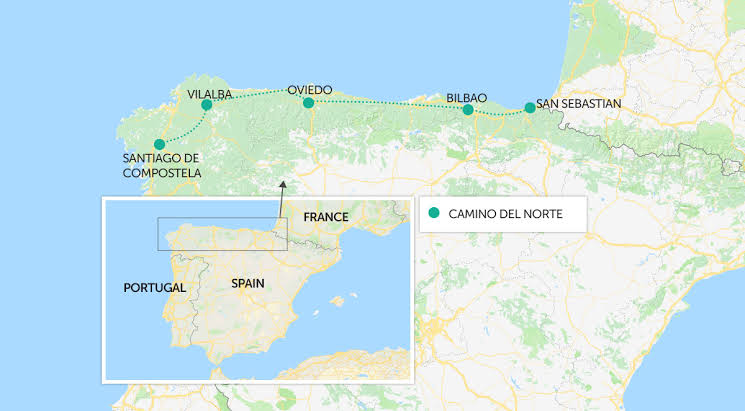The Camino de Santiago, or Way of Saint James, has welcomed pilgrims for over a thousand years. One of the most popular and scenic routes is the Camino del Norte, which runs along Spain’s rugged northern coastline through the Basque Country . Whether you’re an experienced hiker or a first-time traveler, this route offers a journey full of spiritual reflection, breathtaking coastal views, and unforgettable experiences.
Start planning your Spain holiday
Experience the beauty of Spain. Find the best ferry fares and accommodation to suit your style and budget. Your perfect getaway is just a few clicks away.
What is the Camino de Santiago?
The Camino de Santiago is Europe’s oldest and most famous pilgrimage, leading to Santiago de Compostela in northwest Spain, where the tomb of Saint James is located. For centuries, people have walked these paths, whether for spiritual reasons, personal reflection, or just the thrill of the journey.
The Camino de Santiago is the oldest and most popular pilgrimage in Europe.
One of the most stunning — and challenging — routes is the Camino del Norte, which runs along Spain’s northern coast through the Basque Country. This path offers breathtaking views of the Atlantic, charming seaside towns, and hilly trails that make every step feel like an adventure.
Whether you’re after a bit of reflection or simply want to take in the beauty of nature, the Camino del Norte has something for everyone.
Holidays to Basque Country
What is the Camino del Norte (Northern Way)?
The Camino del Norte, or Northern Way, is one of the most captivating routes of the Camino de Santiago, following Spain’s northern coastline, known as “Green Spain”. Starting in the French Basque Country, it offers a mix of rugged mountain trails, beautiful beachside paths, and charming ancient villages.
The Northern Way of the Camino offers breathtaking views and peaceful beachside paths along the Basque Coast.
Where does the journey of the Northern Way begin?
Most pilgrims start their journey in Irún, a small town near the French-Spanish border. But if you’re looking for an easier start, you can also begin in San Sebastián renowned as one of Europe’s top cities for Michelin-starred dining. It’s the perfect place to kick off your journey, soaking in the city’s charm before hitting the trail.
From there, the route heads west, passing through picturesque towns and beautiful landscapes on its way to Santiago de Compostela. How long is the Camino de Santiago (Way of St James) in the Basque Country? The Camino de Santiago in the Basque Country spans about 175 kilometers from the French border near Irun, following the coastline and then inland through scenic landscapes, ending in Bilbao. As part of the Northern Route, it features coastal views and cultural landmarks. From Hondarribia to San Sebastián: Start your journey at the Santiago Bridge in Irun along the Coastal Route. Explore coastal mountains and fishing villages like Hondarribia, and cross rivers such as Pasaia. End your trip in San Sebastián (Donostia), where you can enjoy the coast and local culture.
From San Sebastián to Zarautz: From San Sebastián, the path leads into the countryside with views of the Cantabrian coast. You’ll pass Orio, known for its Camino history, and climb Talaimendi Hill, where local txakoli vineyards are visible, before reaching Zarautz.
From Zarautz to Deba: Follow the coastal mountains for breathtaking views of the Cantabrian Sea. The path briefly veers inland toward the town of Itziar, where you can find an ancient shrine featuring a black virgin. The stage concludes in Deba, a charming coastal town that serves as the perfect place to rest.
From Deba to Markina-Xemein: The path goes from the coast to the mountains and forests as you travel from Gipuzkoa to Bizkaia. This area feels more peaceful and remote. The journey ends in Markina-Xemein, a town known for its beautiful old buildings that reflect the region’s history.
Markina-Xemein is the loneliest and toughest part of the Camino del Norte, but also one of the most beautiful.
From Markina-Xemein to Gernika-Lumo: Starting in the lovely town of Bolibar, this stage takes you past the historic Collegiate Church of Ziortza and through lush woods and valleys. You’ll eventually arrive in the historic town of Gernika, where you can visit the famous Assembly House and the ancient Oak of Gernika.
From Gernika-Lumo to Bilbao: The terrain flattens as you travel through rural towns in Bizkaia. You follow the ‘oath-swearing path’ used by feudal lords. The journey ends in Bilbao, a city known for its industrial history and modern culture, with impressive architecture and a vibrant arts scene.
Take the chance to visit Bilbao, a city known for its industrial history and modern culture.
Can I walk part of the Camino de Santiago route?
Absolutely! Many people walk just a section of the Camino. If you cover at least 100 kilometres (about 62 miles), you can still earn the Compostela certificate. The Basque Country section, about 175 kilometres long, is a popular choice, offering beautiful coastal views and a great introduction for first-timers or travellers with limited time.
You can walk just a part of the Camino! Cover at least 100 kilometers and earn the Compostela certificate.
When is the best time to walk the Camino?
The best time to walk the Camino del Norte is late spring (May to June) or early autumn (September to October) for mild weather and fewer tourists. However, the northern coast can be unpredictable, with rain, fog, and cool temperatures, even in summer. Pack layers and waterproof gear, especially for exposed coastal areas.
Take a rain jacket and warm layers with you—the rain is a constant companion on the Camino.
Do you require hiking experience?
You do not need any hiking experience to walk the Camino del Norte, but being reasonably fit is helpful. The trail has a variety of terrains, with some parts being rocky and hilly. Although the path is generally well-marked, certain sections can be challenging due to steep climbs and descents, as well as occasional coastal winds and rain.
Set your own pace, take breaks, and adjust your daily distance as you go.
Most walkers go at their own pace, taking breaks and adjusting their daily distances based on their fitness levels. The route is accessible to people of all abilities, but it’s important to be prepared for long days of walking and a few tougher sections.
How to find your way on the Camino del Norte?
The Camino del Norte has clear signs, like yellow arrows and scallop shell symbols, that help walkers stay on the path. These signs are easy to see and help you stay on track. However, it can be helpful to have a guidebook or map, especially in less busy areas.


